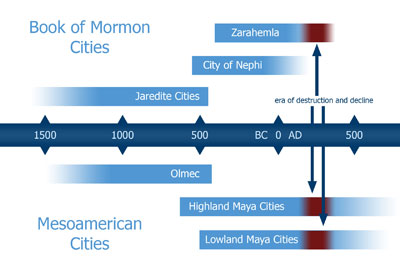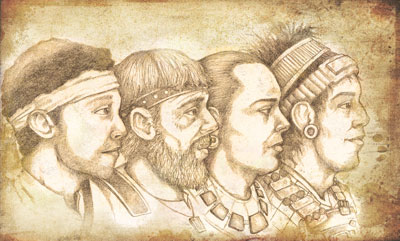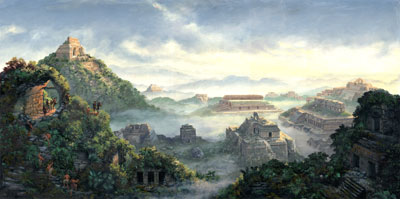
The Know
Although typically thought of as a Nephite record, the Book of Mormon actually describes the rise and fall of two peoples. It begins with Lehi in Jerusalem, follows his family’s journey to the promised land, and the remainder of the book primarily chronicles the history of their descendants.
Then there is a small part that describes the rise and fall of an earlier people, the Jaredites, whose prophets had warned them that unless they repented, “the Lord God would execute judgment against them to their utter destruction” and then “bring forth another people to possess the land” (Ether 11:20–21).
The history of Mesoamerica also shows the rise and fall of two major cultures during parallel time periods (see chart).1 John E. Clark, a Latter-day Saint and prominent Mesoamerican archaeologist, noted, “The two-civilizations requirement used to be a problem for the Book of Mormon, but it no longer is now that modern archaeology is catching up.”2
Scholars refer to the first civilization as the Olmec, which arose in the mid-second millennium BC and collapsed around 400 BC.3 According to Clark, “the earliest developments of Jaredites and Olmecs are hazy, but from about 1500 BC onward their histories are remarkably parallel.” From there, “The alternations between city building and population declines, described for the Jaredites, correspond quite well with lowland Olmec developments.”4
Clark has further noted, “In eastern Mesoamerica, Olmec civilization was replaced by the lowland Maya, who began building cities in the jungles of Guatemala about 500 to 400 BC.”5 The preclassic Maya “experienced peaks and troughs of development, with a mini-collapse about AD 200.”6 While the final Nephite battles are fought in the fourth century AD, the beginnings of their fall are sown ca. AD 200–210, when after reaching the height of prosperity, religious corruption and social stratification again sets in and proves to be divisive (4 Nephi 1:24–29).
John L. Sorenson has pointed out that, corresponding with the annihilation of the Nephites, many Mesoamerican cities were abandoned, destroyed, then rebuilt by invaders in the fourth century AD.7 This led Sorenson to conclude, “The picture derived from archaeology thus agrees basically with the Book of Mormon story of the Nephites’ retreat.”8
The Why
While the geography of the Book of Mormon is not known with certainty, “the correspondences between the Book of Mormon and cycles of Mesoamerican civilization are striking.”9 It would be a mistake to assume that the Jaredites are the Olmec and that the Nephites/Lamanites are the Maya. Rather, the consistency in their cycles of civilization suggests that Jaredite and Nephite history could have unfolded within the broader context of Mesoamerican history.10
Significantly, “The Olmecs … were not identified as a real culture until 1942, and archaeologists did not know their true age until 1967.”11 Lacking awareness of early Mesoamerican civilizations and their chronologies, early critics naturally criticized the Book of Mormon’s presentation of twofold civilization.12 But as Clark rightly argued, “If early critics cannot be faulted for failing to predict these discoveries, the Book of Mormon should not be denigrated for getting them right.”13
By telling the stories of both Nephite and Jaredite societies and their destructions, the Book of Mormon drives home its powerful warning for modern readers. As Steven C. Walker observed, “It is because what happened to the Jaredites happens to the Nephites,” that, “more presciently, we sense its potential for ourselves.”14 The Book of Mormon is a divinely appointed warning for the modern day, twice illustrating the downfall that awaits societies that succumb to wickedness and corruption.
Whether or not Book of Mormon peoples were in Mesoamerica or somewhere else, the archaeology of the Olmec and preclassic Maya confirms that the collapse of civilization is more than just a cautionary tale. This is further affirmed with the rise and fall of post-Book of Mormon Mesoamerican civilizations like Teotihuacan,15 the Classic Maya,16 the postclassic Maya, and the Aztec.17
The kingdoms of Israel and Judah, and the great empires that once conquered them—Egypt, Assyria, Babylon, Persia, Macedonia, and Rome—all testify of the same fate. Archaeology and history literally the world over attest to the rise and fall of great civilizations, providing a second witness alongside the Book of Mormon, assuring modern readers “that complete deterioration of civilization, and even utter annihilation, are possibilities for even the seemingly invincible United States” and other world powers of the modern age.18
Yet while the history of the world is filled with seemingly invincible civilizations that subsequently became ancient history, only the Book of Mormon diagnoses the root of the problem, and only the Book of Mormon has the antidote. Many factors can contribute to the rise and fall of civilizations, but only adherence to the principles taught by Jesus Christ, as found in 3 Nephi and elsewhere in scripture, can stem the tide of social decay and stave off destruction.19
Further Reading
John L. Sorenson, Mormon’s Codex: An Ancient American Book (Salt Lake City and Provo, UT: Deseret Book and Neal A. Maxwell Institute for Religious Scholarship, 2013), 499–595.
John E. Clark, “Archaeological Trends and Book of Mormon Origins,” in The Worlds of Joseph Smith: A Bicentennial Conference at the Library of Congress, ed. John W. Welch (Provo, UT: BYU Press, 2006), 89–93.
John E. Clark, “Archaeology, Relics, and Book of Mormon Belief,” Journal of Book of Mormon Studies 14, no. 2 (2005): 48–49.
John L. Sorenson, Images of Ancient America: Visualizing Book of Mormon Life (Provo, UT: FARMS, 1999), 192–217.
John L. Sorenson, An Ancient American Setting for the Book of Mormon (Salt Lake City and Provo, UT: Deseret Book and FARMS, 1985), 108–137.
- 1. Chart from John E. Clark, “Archaeology, Relics, and Book of Mormon Belief,” Journal of Book of Mormon Studies 14, no. 2 (2005): 48; John E. Clark, “Archaeological Trends and Book of Mormon Origins,” in The Worlds of Joseph Smith: A Bicentennial Conference at the Library of Congress, ed. John W. Welch (Provo, UT: BYU Press, 2006), 91. For the most thorough correlation made to date of the rise and fall of the Olmec and preclassic Maya with Jaredites and Nephites, see John L. Sorenson, Mormon’s Codex: An Ancient American Book (Salt Lake City and Provo, UT: Deseret Book and Neal A. Maxwell Institute for Religious Scholarship, 2013), 499–695. See also John L. Sorenson, An Ancient American Setting for the Book of Mormon (Salt Lake City and Provo, UT: Deseret Book and FARMS, 1985), 108–137; John L. Sorenson, Images of Ancient America: Visualizing Book of Mormon Life (Provo, UT: FARMS, 1999), 192–217. Note that Sorenson’s Jaredite chronology differs from Clark’s.
- 2. Clark, “Archaeology, Relics, and Book of Mormon Belief,” 48.
- 3. See Clark, “Archaeology, Relics, and Book of Mormon Belief,” 48. Joel W. Polka, “Olmec,” in The A to Z of Ancient Mesoamerica (Lenham, MD: Scarecrow Press, 2010), 92–93 dates the Olmec to 1750–400 BC. Richard E. W. Adams, Prehistoric Mesoamerica, third edition (Norman, OK: University of Oklahoma, 2005), 55–56 discusses Olmec chronology and periodization, ca. 1600–300 BC.
- 4. Clark, “Archaeology, Relics, and Book of Mormon Belief,” 48. Clark, “Archaeological Trends and Book of Mormon Origins,” 93: “The Olmec population grows and falls in respectable parallel to that of the Jaredites’ reported increase and demise.” Brant A. Gardner, Traditions of the Fathers: The Book of Mormon as History (Salt Lake City, UT: Greg Kofford Books, 2015), 406, agreed: “The Olmec and the Jaredites overlap in time depth and geography.” However, Gardner used a different chronology for the Jaredites, shifting them a few hundred years forward in time to ca. 1100–200 BC. See Brant A. Gardner, Second Witness: Analytical and Contextual Commentary on the Book of Mormon, 6 vols. (Salt Lake City, UT: Greg Kofford Books, 2007), 6:146–149. On his later dating of the collapse of the Jaredites, Gardner pointed out, “a [Olmec] related late tradition called the epi-Olmec lasting through 200 BC.” (Gardner, Traditions of the Fathers, 395.) Gardner thus reasoned that “the devastating wars of annihilation in Ether” were part of “the aftermath of the Olmec political collapse.” (Gardner, Second Witness, 147.)
- 5. Clark, “Archaeology, Relics, and Book of Mormon Belief,” 48. Adams, Prehistoric Mesoamerica, 104–109, 132–133 mentions the rise of several regional centers, pyramids, and monumental architecture between 550–400 BC.
- 6. Clark, “Archaeology, Relics, and Book of Mormon Belief,” 48.
- 7. Sorenson, Images of Ancient America, 210. See also Sorenson, Ancient American Setting, 131–137; Sorenson, Mormon’s Codex, 666–695. Adams, Prehistoric Mesoamerica, 210–211 discusses the fall of certain preclassic sites and increased militarization in the late-4th century AD.
- 8. Sorenson, Images of Ancient America, 210. Converging with the picture painted by Clark and Sorenson, Francisco Estrada-Belli argued, “By 500 BC the Lowland Maya had developed a sophisticated civilization. It reached its peak around AD 100, after which time it underwent a political reorganization, and some centers were abandoned.” Francisco Estrada-Belli, The First Maya Civilization: Ritual and Power Before the Classic Period (New York, NY: Routledge, 2011), back cover. Estrada-Belli pointed out defensive earthworks which suggest “civil unrest and endemic warfare” plagued declining cities in the centuries after AD 100 (p. 65), culminating in the 3rd and 4th centuries when many preclassic sites were completely abandoned or show evidence of militarized takeover (pp. 127–137). Specifically, Estrada-Belli suggested that El Mirador, after centuries of decline, was fatally attacked sometime around or after AD 300, after which it was rapidly abandoned once and for all (pp. 127–128). He likewise proposed that Cival was under attack around the same time, with its final abandonment occurring around AD 300 (pp. 131–134). Holmul, on the other hand, did not experience total abandonment, but rather underwent a militarized take over from Teotihuacan documented in inscriptions from the late 4th to early 5th centuries AD (pp. 133–137).
- 9. Clark, “Archaeology, Relics, and Book of Mormon Belief,” 48.
- 10. Gardner, Traditions of the Fathers, 406–407.
- 11. Clark, “Archaeological Trends and Book of Mormon Origins,” 91.
- 12. Clark, “Archaeological Trends and Book of Mormon Origins,” 89–90.
- 13. Clark, “Archaeological Trends and Book of Mormon Origins,” 91.
- 14. Steven C. Walker, “Last Words,” in The Reader’s Book of Mormon, 7 vols., ed. Robert A. Rees and Eugene England (Salt Lake City, UT: Signature Books, 2008), 7:xiii.
- 15. On the collapse of Teotihuacan, see Jeffrey R. Parsons and Yoko Sugira Y., “Teotihuacan and the Epiclassic in Central Mexico,” in The Oxford Handbook of Mesoamerican Archaeology, ed. Deborah L. Nichols and Christopher A. Pool (New York, NY: Oxford University Press, 2012), 309–323.
- 16. On the collapse of the Classic Maya, see David Webster, The Fall of the Ancient Maya: Solving the Mystery of the Maya Collapse (New York, NY: Thames and Hudson, 2002); David Webster, “The Classic Maya Collapse,” in Oxford Handbook of Mesoamerican Archaeology, 324–334.
- 17. The postclassic Maya and the Aztec empire fell at the hands of the Spanish (and their native allies). See Michel R. Oudijk, “The Conquest of Mexico,” Oxford Handbook of Mesoamerican Archaeology, 459–467.
- 18. Walker, “Last Words,” 7:xiii.
- 19. See Book of Mormon Central, “Why Did the Peace Last So Long in 4 Nephi? (4 Nephi 1:16),” KnoWhy 225 (November 7, 2016).
Continue reading at the original source →






